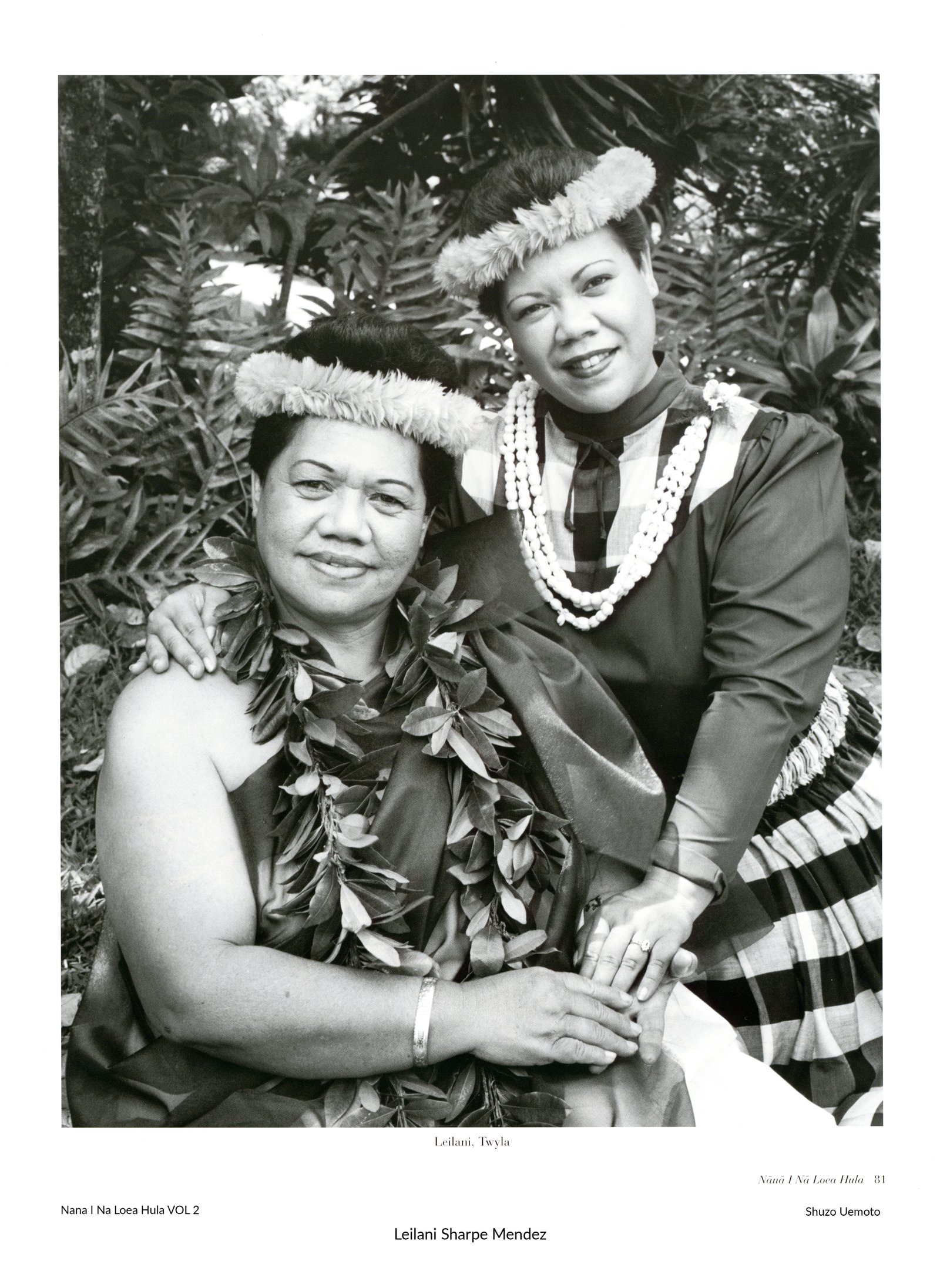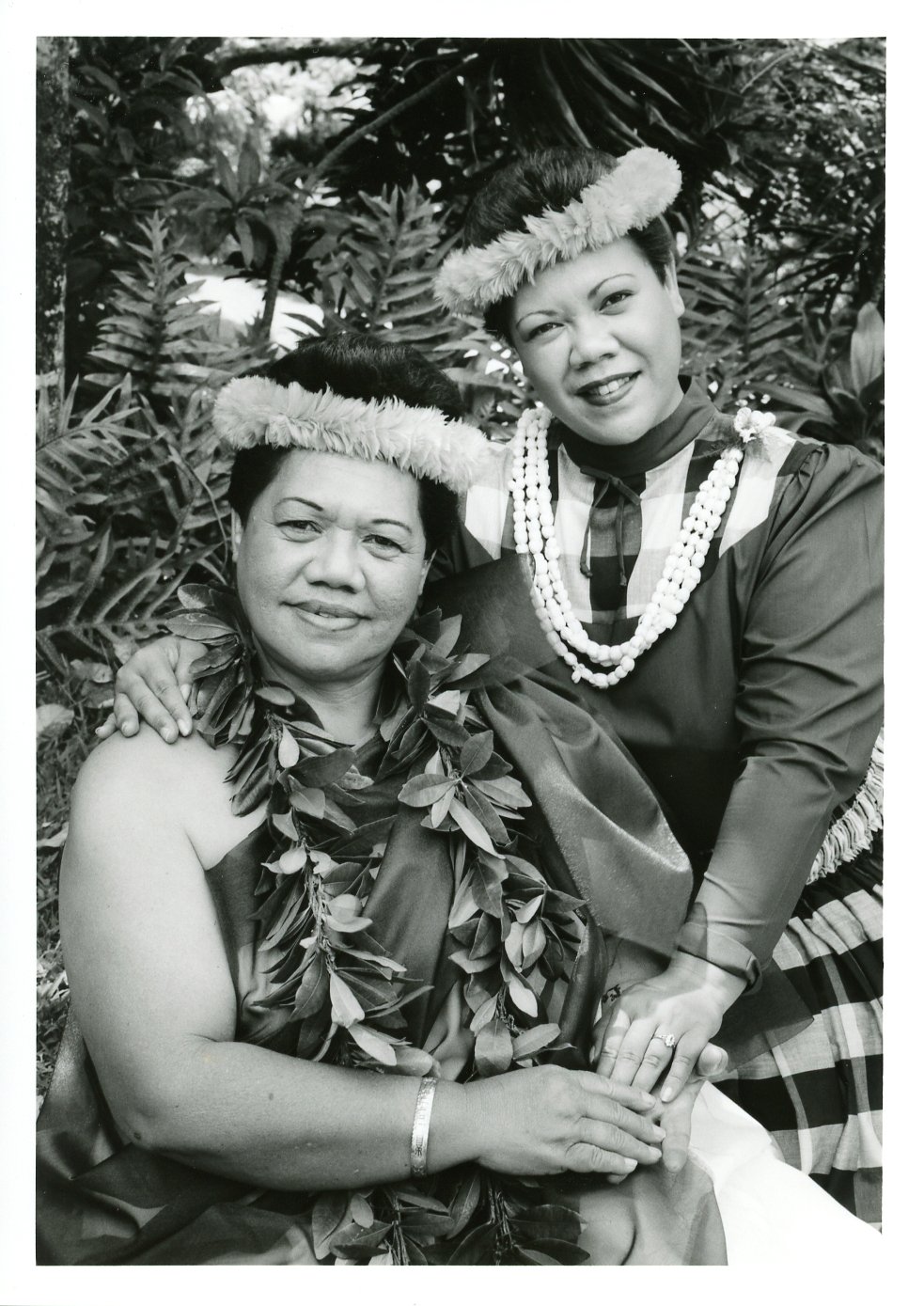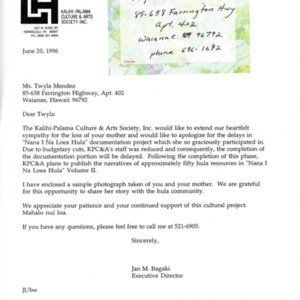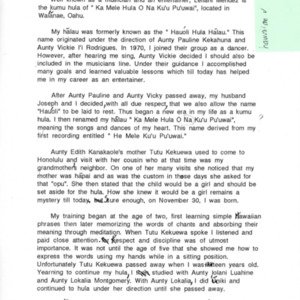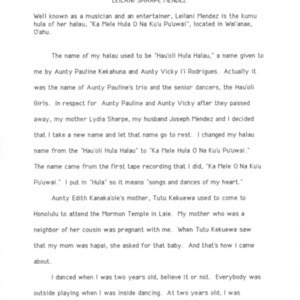Leilani Sharpe Mendez
Title
Leilani Sharpe Mendez
Subject
Nā Kumu Hula LeiIani Sharpe Mendez - Nānā I Nā Loea Hula Volume 2 Page 80
Description
Well-known as a musician and an entertainer, the late Leilani Mendez taught hula for almost fifty years.
Aunty Edith Kanaka‘ole’s mother Tūtū Kekuewa used to come to Honolulu and visit with her cousin who at that time was my grandmother’s neighbor. On one of her many visits she noticed that my mother was hapai and as was the custom in those days she asked for that ‘“opu.” She then stated that the child would be a girl and should he set aside for the hula. How she knew it would be a girl remains a mystery till today. Sure enough on November 30 I was born.
My training began at the age of two, first learning simple Hawaiian phrases then later memorizing the words of chants and absorbing their meaning through meditation. When Tūtū Kekuewa spoke, I listened and paid close attention. Respect and discipline was of utmost importance. It was not until the age of five that she showed me how to express the words using my hands while in a sitting position. Unfortunately Tūtū Kekuewa passed away when I was thirteen-years-old. I wanted to continue my hula so I studied with Aunty ‘Iolani Luahine and Aunty Lokalia Montgomery. I went through an ʻūniki with Aunty Lokalia and continued to dance under her direction until she passed away.
The ‘auana was taught to me by Leilani Alama and later I danced with Aunty Sally Wood Naluaʻi. In addition to the ‘auana, Aunty Sally also taught me the hula pahu or traditional drum dances. Till today I respect her as my primary source of the hula.
Each of my teachers have contributed in significant ways to the insights I have for the hula. The most important lessons impressed upon me through the years were humility and respect. Humility allows you to absorb and retain knowledge, and respect enables you to share this knowledge in a manner which adheres to the traditions of our ancestors, in order to possess these qualities one must have faith in the Lord. For He is the source of your gifts, the ability to sing and create the motions in perpetuation of the music of Hawaiʻi.
My hālau was formerly known as the Hau'oli Hula Hālau. This name originated under the direction of Aunty Pauline Kekahuna and Aunty Vickie Iʻi Rodrigues. In 1970 I had joined their group as a dancer, however after hearing me sing. Aunty Vickie decided I should also be included in the musicians line. Under their guidance I learned valuable lessons which have helped me in my career as an entertainer.
After Aunty Pauline and Aunty Vickie passed away, my husband Joseph and I decided that we would lay the name “Hau‘oli ’ to rest. Thus began a new era in my life as a kumu hula. I renamed my hālau Ka Mele Hula O Kuʻu Pu’uwai meaning “the hula songs and dances of my heart.” This name came from my first recording entitled “He Mele Ku‘u Pu‘uwai.”
I feel that my style is very unique. In addition to the traditional basic steps taught in the hula, my students gradually acquire the smooth lift of their feet which is often referred to as the “Hau‘oli style.” I feel this style derived from my training with Tūtū Kekuewa for when she danced she also lifted her feet and was light as a feather and graceful as a bird in flight.
Through the years I have seen a remarkable renaissance of the hula which has spread through many parts of the world. Although this has generated a strong interest in the preservation of this art, there are certain aspects I find very disturbing.
At one time a kumu was regarded with much respect for they were the authorities or masters of the hula. Each individual possessed a unique style yet all shared a common goal, to preserve and retain the rich traditions of the hula as it was handed down by our forefathers.
Today the name “kumu hula” is simply a title for all that is required to become a teacher is a few years of hula and a general excise tax license. Unfortunately due to their limited knowledge and training, they lack originality and depend on the hard work of others to fulfill their requirements as a teacher. Another discouraging fact is the use of modern steps and movements in the kahiko. If we allow these changes to continue, eventually like our lands, language, and music, we will lose the roots or foundation of the hula. The hula will be transformed beyond recognition and this time we will have no one to blame but ourselves.
My greatest accomplishment is that I have been able to train my daughters and instill within them the love and respect I have for the hula. Twyla Ululani Mendez was awarded Miss Aloha Hula at the Merrie Monarch Festival in 1984. She is gifted with the creative ability of the hula kahiko and continues to assist me as the alaka‘i of my hālau. My daughter Cheryl also follows in my footsteps and has a show group in Hilo. She is gifted with words and I often call upon her to research and format my larger production shows.
80 Leilani Sharpe Mendez
Aunty Edith Kanaka‘ole’s mother Tūtū Kekuewa used to come to Honolulu and visit with her cousin who at that time was my grandmother’s neighbor. On one of her many visits she noticed that my mother was hapai and as was the custom in those days she asked for that ‘“opu.” She then stated that the child would be a girl and should he set aside for the hula. How she knew it would be a girl remains a mystery till today. Sure enough on November 30 I was born.
My training began at the age of two, first learning simple Hawaiian phrases then later memorizing the words of chants and absorbing their meaning through meditation. When Tūtū Kekuewa spoke, I listened and paid close attention. Respect and discipline was of utmost importance. It was not until the age of five that she showed me how to express the words using my hands while in a sitting position. Unfortunately Tūtū Kekuewa passed away when I was thirteen-years-old. I wanted to continue my hula so I studied with Aunty ‘Iolani Luahine and Aunty Lokalia Montgomery. I went through an ʻūniki with Aunty Lokalia and continued to dance under her direction until she passed away.
The ‘auana was taught to me by Leilani Alama and later I danced with Aunty Sally Wood Naluaʻi. In addition to the ‘auana, Aunty Sally also taught me the hula pahu or traditional drum dances. Till today I respect her as my primary source of the hula.
Each of my teachers have contributed in significant ways to the insights I have for the hula. The most important lessons impressed upon me through the years were humility and respect. Humility allows you to absorb and retain knowledge, and respect enables you to share this knowledge in a manner which adheres to the traditions of our ancestors, in order to possess these qualities one must have faith in the Lord. For He is the source of your gifts, the ability to sing and create the motions in perpetuation of the music of Hawaiʻi.
My hālau was formerly known as the Hau'oli Hula Hālau. This name originated under the direction of Aunty Pauline Kekahuna and Aunty Vickie Iʻi Rodrigues. In 1970 I had joined their group as a dancer, however after hearing me sing. Aunty Vickie decided I should also be included in the musicians line. Under their guidance I learned valuable lessons which have helped me in my career as an entertainer.
After Aunty Pauline and Aunty Vickie passed away, my husband Joseph and I decided that we would lay the name “Hau‘oli ’ to rest. Thus began a new era in my life as a kumu hula. I renamed my hālau Ka Mele Hula O Kuʻu Pu’uwai meaning “the hula songs and dances of my heart.” This name came from my first recording entitled “He Mele Ku‘u Pu‘uwai.”
I feel that my style is very unique. In addition to the traditional basic steps taught in the hula, my students gradually acquire the smooth lift of their feet which is often referred to as the “Hau‘oli style.” I feel this style derived from my training with Tūtū Kekuewa for when she danced she also lifted her feet and was light as a feather and graceful as a bird in flight.
Through the years I have seen a remarkable renaissance of the hula which has spread through many parts of the world. Although this has generated a strong interest in the preservation of this art, there are certain aspects I find very disturbing.
At one time a kumu was regarded with much respect for they were the authorities or masters of the hula. Each individual possessed a unique style yet all shared a common goal, to preserve and retain the rich traditions of the hula as it was handed down by our forefathers.
Today the name “kumu hula” is simply a title for all that is required to become a teacher is a few years of hula and a general excise tax license. Unfortunately due to their limited knowledge and training, they lack originality and depend on the hard work of others to fulfill their requirements as a teacher. Another discouraging fact is the use of modern steps and movements in the kahiko. If we allow these changes to continue, eventually like our lands, language, and music, we will lose the roots or foundation of the hula. The hula will be transformed beyond recognition and this time we will have no one to blame but ourselves.
My greatest accomplishment is that I have been able to train my daughters and instill within them the love and respect I have for the hula. Twyla Ululani Mendez was awarded Miss Aloha Hula at the Merrie Monarch Festival in 1984. She is gifted with the creative ability of the hula kahiko and continues to assist me as the alaka‘i of my hālau. My daughter Cheryl also follows in my footsteps and has a show group in Hilo. She is gifted with words and I often call upon her to research and format my larger production shows.
80 Leilani Sharpe Mendez
Citation
“Leilani Sharpe Mendez,” Nā Kumu Hula Archive, accessed February 23, 2025, https://nakumuhula.org/archive/items/show/138.
